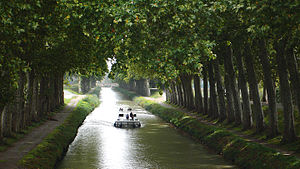
A summit-level canal, sometimes called a "watershed canal" or just "summit Canal", is an artificial waterway connecting two separate river valleys. The term refers to a canal that rises to cross a summit then falls down the other side.[1]
Typically, summit-level canals include a summit pound, a level stretch of water at the highest part of the canal, usually contained by locks that prevent the water from flowing downstream in either direction. Since water flows out when locks open to admit boats, the summit pound must have a water supply.
By contrast, a lateral canal has a continuous fall only.[1]
Summit-level canals were an essential step in the extension of transport systems before the development of railways and modern highways.[citation needed]
- ^ a b "Canals and inland waterways". Encyclopædia Britannica. Retrieved 10 June 2016.